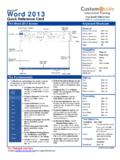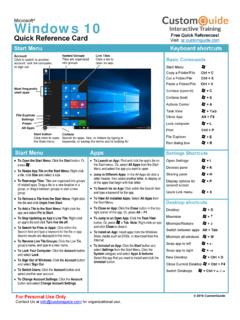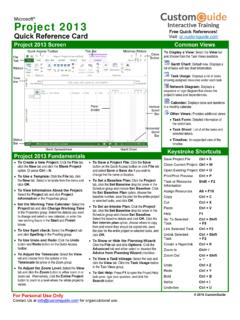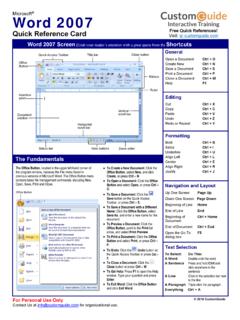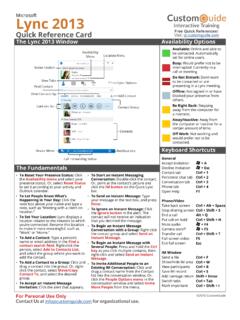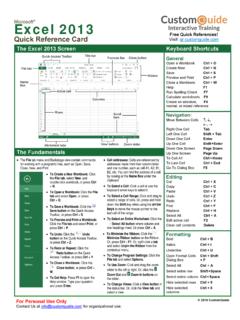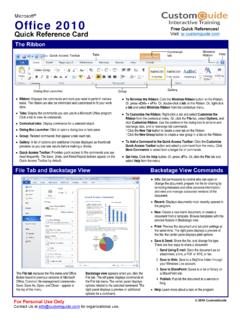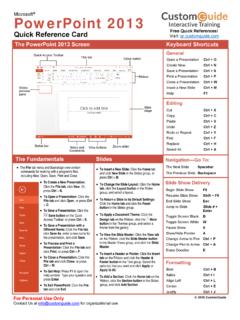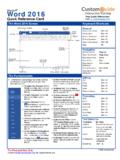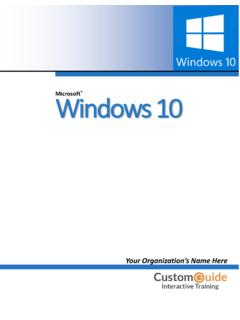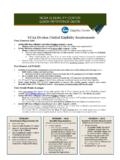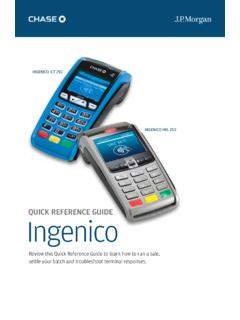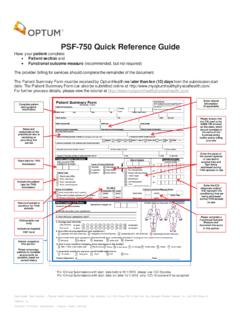Transcription of Windows 8 Quick Reference - CustomGuide
1 MicrosoftWindows 8 Quick Reference Card 2016 CustomGuideFor Personal Use OnlyContact Us at for organizational use. Free Quick References!Visit: Start Screen Start ScreenKeyboard ShortcutsStart Screen & Charms Start screen or jump to previous app from Start ScreenCharms barSharing paneSettings paneDevices paneSearch PaneSearch within appSearch filesSearch settings and control panelsJump to last app + C + H + I + K + S + Q + F +W + Tab Basic CommandsLock computerPrintFile ExplorerPresentation mode Move app one display to the leftMove app one display to the rightSnap app leftSnap app rightQuick Link menuRun dialog boxClose appStop or Close current task + L CTrL + P + E + P + PgUP + PgDn + + + X + r aLT + F4 ESCD esktop ShortcutsDesktopMaximizeMinimize/Restore Switch between appsMinimize allShow/Hide Preview pane + D + + + Tab + M aLT + PApps To Open the Start Screen: Place yourcursor in the lower left corner of thescreen and click the Start screen , view the Charms bar and click Start.
2 To View the Charms Bar: Place yourcursor in the upper right or lower rightcorner of the window. Move the cursortowards the icons to make the buttonsfully appear. To Zoom Out from the Start Screen:Click the Summary View button in thebottom right corner of the screen. To Resize App Tile on the Start Screen:Right-click a tile and click the Resizebutton that appears on the bottom either Large, Medium, Wide, orSmall. To Rearrange Tiles: Tiles are organizedinto columns of related apps. Drag a tileto a new location in a column, or drag itbetween columns to start a new column. To Remove a Tile from the Start Screen:Right-click the app and click the Unpinfrom Start button on the bottom bar. To Add a Tile to the Start Screen: Right-click the app and click the Pin to Startbutton on the bottom bar. To Stop Updating an App s Live Tile:Right-click an app s tile and click the Turnlive tile off button on the bottom bar. To Search for Files or Settings: Point tothe top right corner of the screen, clickthe Search button on the Charms bar,and select either Files or Settings.
3 Or, juststart typing while on the Start screen. To Launch an App: Click the app s tile onthe Start screen or search for the app. To Search for an App: On the Start screen,start typing the app s name. Or, point tothe top right corner of the screen and clickSearch on the Charms bar. To View All Installed Apps: Click the ViewApps button in the bottom left corner ofthe screen. To Close an App: Point to the top of thescreen to make the hand icon appear. Clickand drag the app off the bottom of thescreen. To Jump to an Open App: Place yourcursor in the upper left corner of thescreen and click the thumbnail thatappears. To view all open apps, move yourcursor from the corner down the left edge. To View App Commands: Right-clickwhile inside the app. A horizontal bar withoptions for the app appears at the bottomof the screen. To Install an App: Install apps from theWindows Store, from media such as DVDs,or download them from the internet. To Uninstall an App: Right-click the appand click Uninstall on the bottom bar.
4 To View Multiple Apps at Once: Open alldesired apps. From within one app, placeyour cursor in the upper left corner ofthe screen. Click the thumbnail of anotherapp and drag it down onto the left or rightedge of the screen. Note that only highresolution displays will show more thantwo apps at once. 2016 CustomGuideFor Personal Use OnlyContact Us at for organizational use. DesktopCharms BarSearchSettings and PersonalizationMaintenanceThe Desktop is familiar from previous versions of Windows . Desktop applications like Microsoft Office, File Explorer, and the Control Panel run here. Use the same keystroke shortcuts, corner hotspots, and Charms bar you use in the Start screen to navigate the desktop. To Use the Desktop: From the Start screen, click theDesktop tile. To Open a Program: Click the Start button, click the ViewApps button, and select a program. To Create a Desktop Shortcut: Click the Start button,click the View Apps button, right-click the program, and select Open File Location from the bottom bar.
5 Right-click the program icon, click Send to, and then select Desktop (create shortcut). Note that this can not be done for built-in apps such as Weather, Calendar, or Xbox Music. To Peek at Open Windows : Point to a program icon on thetaskbar. Point at the resulting thumbnail preview to peek at the window. To Minimize All Other Windows : Click the title bar of thewindow that you would like to stay open and quickly drag it from side to side. All other open Windows will minimize. To Compare Windows Side by Side: Click and drag awindow s title bar to the right side of the screen, and drag the other window to the left side of the screen. To Maximize an Open Window: Click and drag the windowto the top of the screen. Or, click the Maximize/Restore button in the upper right corner of the title bar. To Switch Between Windows : Click the program icon onthe task bar for the window that you would like to view To Access the Control Panel: Right click the Start buttonand select Control Panel. To Pin a Program to the Taskbar: Open the program youwant to pin, right-click the program icon on the taskbar, and select Pin this program to task bar.
6 To Personalize your PC: Point to the upper or lowerright corner of the screen, click the Settings button on the Charms bar, and select either Personalize or Personalization. Note that the personalization options are different depending on whether you are in the Start screen or the traditional Desktop. To Change Other PC Settings: Point to the upper or lowerright corner of the screen, click the Settings button on the Charms bar, and select Change PC Settings. To Change Settings of Apps: Open the app. Point to theupper or lower right corner of the screen and click the Settings button on the Charms bar. App specific settings are displayed, such as changing preferences, finding help, and adding Charms bar helps you quickly do the things you do most often. What you can do with buttons on the Charms bar changes, depending on if you re on the Desktop, the Start screen, or are using an app. Search: Click to search for anything on your for a specific type of file, or search the entire computer.
7 Share: Click to share things with other people such asphotos, documents, or links without leaving the app. Start: Click to jump to the Start screen. If the Start screen isalready displayed, return to the last app you were using, or switch to the traditional Desktop view. Devices: Click to use any device that s connected to yourcomputer. For example, to print a file, to import images from a camera, or to manage a wireless device. Settings: Change settings, find help, and get info foryour PC and apps here. Also find the most common PC settings: volume, brightness, notifications, power, network connection, and keyboard. Access additional settings such as personalization, users, notifications, ease of access, privacy, and much more by clicking Change PC Settings. To Search: Point to the upper or lower right corner of thescreen and click the Search button on the Charms bar. Enter the search term and press Enter. Or, just start typing while on the Start screen. To Filter Results: Select Everywhere, Settings, Files, WebImages, or Web Videos from the drop down menu.
8 To Get Help: Point to the upper or lower right corner of thescreen and click the Search button on the Charms bar, then type Help, and click Help and Support. To Manage Open Apps: Point to the upper left corner untila thumnail appears, then move the mouse down. To close an app, right-click an app s thumbnail and select Close. To Refresh your PC: Point to the upper or lower rightcorner of the screen and click the Settings button on the Charms bar. Click Change PC Settings, click the Update and Recovery category and then select Recovery. Click Get started under the Refresh your PC without affecting your files heading. This is only available to system administrators. To Shut Down your Computer: Windows 8 goes intosleep mode when a laptop is closed, or the power button is pressed on a tablet. To turn your PC completely off, point to the upper or lower right corner of the screen and click the Settings button on the Charms bar. Then click Power and select Shut down. Or, right-click the Start button and select Shut down or sign out.
9 Windows Defender: This free anti-virus program protectsthe computer from downloading viruses and other Training for Over 2,000 Topics: Office 2016 for Windows Excel 2016 Outlook 2016 PowerPoint 2016 Word 2016 Office 2016 for Mac Excel 2016 Outlook 2016 PowerPoint 2016 Word 2016 Office 365 OneDrive for Business Skype for Business Office 2013 Excel 2013 OneNote 2013 Outlook 2013 PowerPoint 2013 SharePoint 2013 Word 2013 Operating Systems Windows 10 Windows 8 Windows 7 Computer Basics Mac OS Also Available Soft Skills Courses Spanish Editions Each Course Includes: Interactive Tutorials Get hands on training with bite sized tutorials that recreate the experience of using actual software. SCORM compatible for your LMS! View Sample Customizable Courseware Why write training materials when we ve done it for you? Training manuals, practice files, and instructor guides with unlimited printing rights! View SampleInteractive Assessments How much do your users really know? Accurately measure skills with realistic software simulations.
10 SCORM compatible for your LMS! View Sample Quick References Handy cheat sheets with shortcuts, tips, and tricks. Free for personal use! View Samples Over 3,000 Companies Rely on CustomGuide We hope you enjoy this free Quick Reference ! Please review our other training products; see the samples below. Please Contact us for a Free Trial! |
